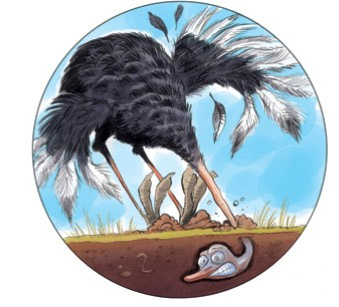当前位置: Language Tips> 英语学习专栏
动物的行为可谓千奇百怪,有些甚至让人瞠目结舌。然而眼见为实,并非所有关于动物的奇闻轶事都是可靠的。让我们一起来擦亮双眼,击破几个早已众所周知且被认作事实的流言吧。

By Stephen Lovgren
经纬 选 张涛 译
|
Animals do some pretty strange things. Giraffes clean their eyes and ears with their tongues. Snakes see through their eyelids. Some snails can hibernate for three years. But other weird animal tales are hogwash. Let’s find out how some of these myths started—and why they’re not true. Myth: Ostriches bury their heads in the sand when they’re scared or threatened. How It Started It’s an optical illusion! Ostriches are the largest living birds, but their heads are pretty small. “If you see them picking at the ground from a distance, it may look like their heads are buried in the ground,” says Glinda Cunningham of the American Ostrich Association. Why It’s Not True Ostriches don’t bury their heads in the sand—they wouldn’t be able to breathe! But they do dig holes in the dirt to use as nests for their eggs. Several times a day, a bird puts her head in the hole and turns the eggs. So it really does look like the birds are burying their heads in the sand! Myth: Opossums hang by their tails. How It Started Opossums use their tails to grasp branches as they climb trees. So it’s not surprising that people believe they also hang from branches. Why It’s Not True A baby opossum can hang from its tail for a few seconds, but an adult is too heavy. Besides, says Paula Arms of the National Opossum Society, that wouldn’t help them survive. “Why would they just hang around? That skill isn’t useful—there’s no point.” Myth: Touching a frog or toad will give you warts . How It Started Many frogs and toads have bumps on their skin that look like warts. Some people think the bumps are contagious. Why It’s Not True “Warts are caused by a human virus, not frogs or toads,” says dermatologist Jerry Litt. But the wart-like bumps behind a toad’s ears can be dangerous. These parotoid glands contain a nasty poison that irritates the mouths of some predators and often the skin of humans. So toads may not cause warts, but they can cause other nasties. It’s best not to handle these critters ! Myth: Mother birds will reject their babies if they’ve been touched by humans. How It Started Well-meaning humans who find a chick on the ground may want to return the baby bird to the nest. But the bird is probably learning to fly and shouldn’t be disturbed. The tale may have been invented to keep people from handling young birds. Why It’s Not True “Most birds have a poorly developed sense of smell,” says Michael Mace, bird curator at San Diego Zoo’s Wild Animal Park. “They won’t notice a human scent.” One exception: vultures, who sniff out dead animals for dinner. But you wouldn’t want to mess with a vulture anyway! Myth: Penguins fall backward when they look up at airplanes. How It Started Legend has it that British pilots buzzing around islands off South America saw penguins toppling over like dominoes when the birds looked skyward. Why It’s Not True An experiment testing the story found that penguins are perfectly capable of maintaining their footing, even if they’re watching airplanes. “But the reality isn’t funny,” says John Shears, who worked on the survey. “Low-flying aircraft can cause penguins to panic and leave their nests.” |
动物们确实会做一些让人意想不到的事。长颈鹿用舌头清洁眼睛和耳朵。蛇透过眼睑看东西。某些种类的蜗牛能冬眠三年之久。不过另一些关于动物的传说则是一派胡言。让我们来看看这些流言是如何产生的——以及它们偏离事实的原因。 流言:鸵鸟受惊或者遇到危险时会把头埋进沙子里。 以讹传讹 这是视觉上的误差!鸵鸟在现存鸟类中体型最大,但是它们的脑袋非常小。“如果你从远处看见它们在地上啄食,它们的脑袋就好像埋进了地里似的,”美国鸵鸟协会的格林达•坎宁安说道。 真相大白 鸵鸟不会把脑袋埋进沙子里——那样它们就没法呼吸了!但是它们确实会在土里挖洞,给自己的蛋做个窝。鸵鸟会一天好几次把头伸进洞里翻蛋。所以它们看起来确实像是把自己的脑袋埋进了沙子里。 流言:负鼠用尾巴倒挂在地上。 以讹传讹 负鼠爬树时用尾巴抓住树枝。因此人们自然而然地就认为负鼠也会用尾巴倒挂在树枝上。 真相大白 一只幼负鼠能用尾巴倒挂几秒钟,但是一只成年负鼠就太重了。另外,(美国)国家负鼠研究学会的宝拉•阿姆斯说,这种技能对它们的生存并没有多大帮助。“它们为什么要悬挂起来?这种技能没有用——这完全没有意义啊。” 流言:触碰青蛙或蟾蜍会让人身上长疣。 以讹传讹 许多青蛙和蟾蜍的皮肤凹凸不平,看起来像长满了疣。有些人认为这些疙瘩会传染。 真相大白 “疣是由人体内的病毒所引发的,并不是因为触碰了青蛙或蟾蜍,”皮肤科医师杰里•利特说道。但是蟾蜍耳朵后面像疣一样的疙瘩是很危险的。这些腮腺的腺体含有一种可恶的毒素,会使一些捕食者的嘴巴发炎;而人触碰了,则常常会引起皮肤发炎。蟾蜍不会传播疣,但它们能引发其他可恶的病症。因此最好别招惹这些小家伙! 流言:如果鸟宝宝被人类碰过,鸟妈妈会拒绝抚养它们。 以讹传讹 好心人会将地上捡到的雏鸟放回巢里。但这只小鸟可能正在学飞,所以最好别打扰它。之所以编出这样的故事,可能是为了让大家不要随意触碰雏鸟。 真相大白 “大部分鸟类的嗅觉都比较差,”圣迭戈动物园野生动物部禽类馆馆长说,“它们不能嗅出人类的气味。” 但有一个特例:秃鹫,它能通过嗅觉找到动物的尸体作为晚餐。但相信你在任何情况下都不会愿意去惹秃鹫的! 流言:企鹅抬头看天上的飞机时,会仰面摔倒。 以讹传讹 传说,在南美洲以南的海岛上空飞来飞去的英国飞行员发现,企鹅朝天上看时会像多米诺骨牌一样一个接一个地倒下。 真相大白 人们做了一个实验检测这个传说的真伪,发现企鹅即使看天上的飞机,也能很好地保持脚下的平衡。“然而现实一点儿也不好笑,”参与该调查的约翰•希尔斯坦说道,“低空飞行的飞机会引起企鹅们的惊恐并离开自己的巢穴。” (来源:英语学习杂志 编辑:丹妮) |
|
Vocabulary: 1. busted: 〈美〉被当场逮到的,(谎言等)被揭穿的。 2. hogwash: 〈俚〉废话,胡说八道。 3. optical: 光学的,视觉的。 4. opossum: 负鼠,主要生活在美洲的一种有袋动物。 5. wart: 疣,由病毒感染而形成的一种皮肤增生。 6. parotoid gland: 腮腺;nasty: 令人不快的,恶毒的;irritate: 使过敏,使发炎;predator: 捕食者,食肉动物。 7. critter: 小生物,小动物。 8. mess with: 与……有牵连,卷入(有害的事)。 9. domino: 多米诺骨牌。 |
上一篇 : 新年决心实现秘诀
下一篇 : 有关13美分的一件大事
电话:8610-84883645
传真:8610-84883500
Email: languagetips@chinadaily.com.cn